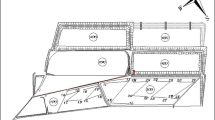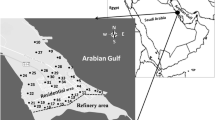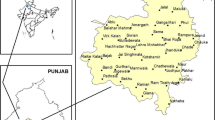Abstract
Analysis of elemental concentration in soil and water was carried out in Ortum to ensure safe utilization of soil and water resources for agriculture, industrial, and household purposes. Elemental analysis of soil and water was done using the EDXRF spectrometer and the inductively coupled plasma – optical emission spectrometry (ICP-OES), respectively. A total of 59 soil samples from different locations and depth and 10 water samples were collected from Ortum using purposive sampling method. The results of the mean elemental composition of 13 elements Ni (ppm), Cu (ppm), Zn (ppm), Pb (ppm), K (%w), Ca (%w), Fe (%w), Ti (%w), Mn (ppm), Rb (ppm), Sr (ppm), Zr (ppm), and Nb (ppm) in soils were 58.11, 46.91, 73.49, 22.20, 3.83, 24.39, 1.72, 7.73, 1529.74, 60.98, 442.26, 410.63, and 29.36, respectively, and the mean of 19 elements Ni, Cu, Pb, Zn, Ag, Al, As, Ba, Ca, Cd, Co, Cr, Fe, K, Mg, Mn, Mo, Na, and Se in water samples in (mg/l) were 0.037, 0.0014, 0.0005, 0.0042, 0.0030, 0.021, 0.0080, 0.12, 73.81, 0.00023, 0.0036, 0.00276, 0.0040, 6.11, 38.18, 0.00023, 0.0032, 46.87, and 0.0026, respectively. The average elemental concentration in soils was within the world average range. The mean concentration of Cu, Zn, and Pb in soil reduced with increase in depth while that of Ni increased with increase in depth. The average metal pollution indices in soils, geoaccumulation index (Igeo) potential ecological risk index (Ei), and synthesized potential ecological risk index (Er) were evaluated and found to be − 0.40, 4.92, and 19.69, respectively. According to the classification index, the results show that the soil in Ortum is moderately polluted, and the risk associated with the measured elemental concentration of Ni, Zn, Cu, and Pb in the soils is low. The elemental concentrations in water samples was lower than the recommended permissible limits except for Calcium (Ca) in borehole water with an average of 90.80 mg/l against the permissible levels of 75 mg/l (WHO, 2011). The pH for water samples was found to range from 6.60 to 7.71 with an average of 7.07 which is within the acceptable range of pH 6.5 to pH 8.5 as recommended by WHO, 2011. The study found out that elemental concentration in soil and water samples from Ortum were withing the world average values and that the soil and water in Ortum is safe for use in agriculture and domestic purposes.








Similar content being viewed by others
References
Angelone, M., & Bini, C. (2017). Trace element concentrations in soils and plants of Western Europe. In Biogeochemistry of trace metals (pp. 31–72). CRC Press.
Balakrishnan, A., & Ramu, A. (2016). Evaluation of heavy metal pollution index (HPI) of ground water in and around the coastal area of Gulf of Mannar Biosphere and Palk Strait. Journal of Advanced Chemical Sciences, 331–333.
Cevik, U., Damla, N., Karahan, G., Celebi, N., & Kobya, A. I. (2006). Natural radioactivity in tap waters of Eastern Black Sea region of Turkey. Radiation Protection Dosimetry, 118, 88–92.
Kabata-Pendias, A., & Mukherjee, A. B. (2007). Trace elements from soil to human. Springer Science & Business Media.
Koki, I. B., Bayero, A. S., Umar, A., & Yusuf, S. (2015). Health risk assessment of heavy metals in water, air, soil and fish. African Journal of Pure and Applied Chemistry, 9(11), 204–210.
Muohi, A. W., Onyari, J. M., Omondi, J. G., & Mavuti, K. M. (2003). Heavy metals in sediments from Makupa and port–Reitz Creek systems: Kenyan coast. Environment International, 28(7), 639–647.
Ojekunle, O. Z., Ojekunle, O. V., Adeyemi, A. A., Taiwo, A. G., Sangowusi, O. R., Taiwo, A. M., & Adekitan, A. A. (2016). Evaluation of surface water quality indices and ecological risk assessment for heavy metals in scrap yard neighbourhood. SpringerPlus, 5(1), 560.
Omoniyi, I. M., Oludare, S. M., & Oluwaseyi, O. M. (2013). Determination of radionuclides and elemental composition of clay soils by gamma-and X-ray spectrometry. Springerplus, 2(1), 74.
Poshtegal, M. K., & Mirbagheri, S. A. (2019). The heavy metals pollution index and water quality monitoring of the Zarrineh River, Iran. Environmental & Engineering Geoscience, 25(2), 179–188.
Scholze, F., Beckhoff, B., Kolbe, M., Krumrey, M., MŘller, M., & Ulm, G. (2006). Detector calibration and measurement of fundamental parameters for X-ray spectrometry. Microchimica Acta, 155(1-2), 275–278.
Sereshti, H., Heravi, Y. E., & Samadi, S. (2012). Optimized ultrasound-assisted emulsification microextraction for simultaneous trace multielement determination of heavy metals in real water samples by ICP-OES. Talanta, 97, 235–241.
Singh, S., Ghosh, N. C., Krishan, G., Kumar, S., Gurjar, S., & Sharma, M. K. (2019). Development of indices for surface and ground water quality assessment and characterization for Indian conditions. Environmental Monitoring and Assessment, 191(3), 182.
Towett, E. K., Shepherd, K. D., Tondoh, J. E., Winowiecki, L. A., Lulseged, T., Nyambura, M., et al. (2015). Total elemental composition of soils in Sub-Saharan Africa and relationship with soil forming factors. Geoderma Regional, 5, 157–168.
Wanjala, O. F., Rathore, I. V. S., & Murungi, J. (2016). Assessment of Heavy Metals Concentration in Soils at Selected Points on Roads and Sites Around Nairobi Using EDXRF Spectrometer
WHO (2011). Guidelines for drinking-water quality. WHO chronicle,38(4), 104-8.
World Health Organization (2011). Guidelines for drinking-water quality: World Health Organization. Distribution and Sales, Geneva, 27.
World Resources. (1998). A guide to the Global Environment. Environmental Change and Human Health. part, 1, 1–386.
Wu, J., Long, J., Liu, L., Li, J., Liao, H., Zhang, M., et al. (2018). Risk Assessment and Source Identification of Toxic Metals in the Agricultural Soil around a Pb/Zn Mining and Smelting Area in Southwest China. International Journal of Environmental Research and Public Health, 15(9), 1838.
Acknowledgments
The authors are grateful to the people of Ortum for their assistance and co-operation in collecting soil and water samples during the field work. We are also grateful to the staff of Kenyatta University, Institute of Nuclear Science and Technology, University of Nairobi and the Kenya Bureau of Standards for providing necessary facilities in carrying out this research work.
Funding
The authors highly acknowledge the financial assistance provided by the Kenya National Research Fund (NRF) and African Development Bank (AfDB) in funding the activities of this research.
Author information
Authors and Affiliations
Corresponding author
Additional information
Publisher’s note
Springer Nature remains neutral with regard to jurisdictional claims in published maps and institutional affiliations.
Rights and permissions
About this article
Cite this article
Wanjala, F.O., Hashim, N.O., Otwoma, D. et al. Environmental assessment of heavy metal pollutants in soils and water from Ortum, Kenya. Environ Monit Assess 192, 118 (2020). https://doi.org/10.1007/s10661-020-8070-3
Received:
Accepted:
Published:
DOI: https://doi.org/10.1007/s10661-020-8070-3




